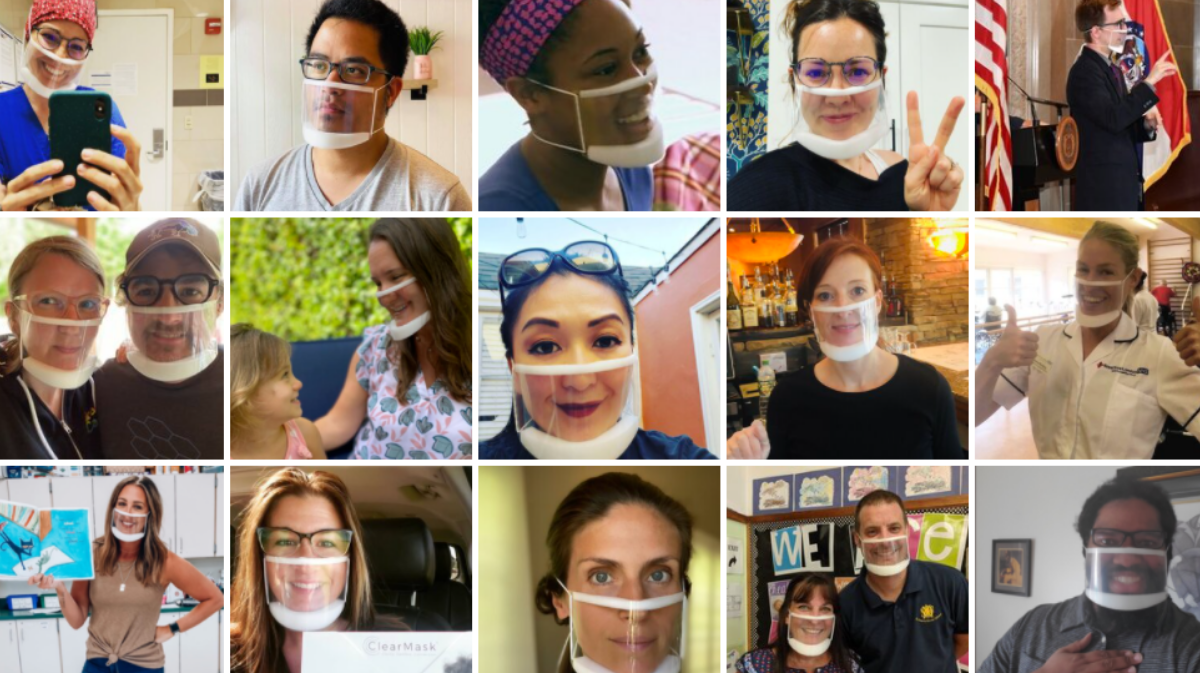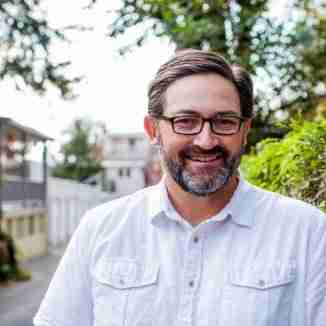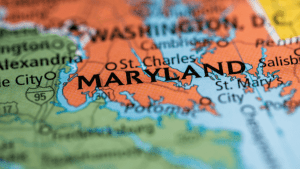
How ClearMask Founders Redesigned PPE for Healthcare Workers, Patients, and Now Apple Employees.
Sometimes, looking at an industry norm from a new perspective yields groundbreaking innovation.
That’s just what happened to the founders of Baltimore, Maryland’s ClearMask who have been on a mission to develop a first-of-its-kind, fully transparent surgical mask to make communication more accessible. This Spring their determination resulted in FDA 510(k) clearance for their novel surgical mask and this month their design attracted a deal with one of the most innovative companies in the world.
On September 9, 2020, Bloomberg reported that Apple will distribute The ClearMask, along with its own masks, as PPE to its store and corporate employees.

The ClearMask’s revolutionary design was inspired by a traumatic 2015 surgical experience of co-founder and current President, Allysa Dittmar, who also happens to be deaf. Dittmar, and three other Johns Hopkins student and alumni, founded ClearMask in 2017 to bring their design to life.
“Allysa requested a sign language interpreter before her surgery, but unfortunately they never showed up due to a scheduling error. She could lip read and get by with visual cues pre-op, but once she got into the operating room, all the doctors and nurses were wearing traditional surgical masks, so she couldn’t read their lips or see facial expressions, and was completely cut off from communicating with anyone around her. They couldn’t communicate critically important patient safety questions like who are you, which side are we operating on, what drugs are you allergic to and what’s your blood type?”, shared Aaron Hsu, ClearMask’s CEO.
“She couldn’t understand them and eventually the surgical team stopped trying to communicate with her and they treated her like a doll. Allysa lost her sense of humanity. When she told me this story, I thought, one, that should never happen to anyone, and two, if you had to go to surgery again or needed to go to the hospital, at the very least, there should be a transparent mask to provide access to visual communication,” he added.
After Dittmar told Hsu about this negative experience, they both went online to research clear surgical facemasks and realized, to their utter surprise, that no one had ever developed a transparent surgical mask before and that there was a clear need that was not being met by anyone.
Inspired to act, Dittmar and Hsu began pulling a team together to pursue developing and commercializing what was then a nascent idea: The ClearMask. In 2016, they connected with fellow founders Inez Lam, who is now ClearMask’s Chief Technology Officer (CTO) and a current Ph.D. candidate at JHU, and Elyse Heob, the company’s Chief Operating Officer (COO).
“With my engineering background, the moment I heard about this I had the same reaction as Aaron and Allysa. The idea is so simple, why hasn’t this already been done? The ClearMask is such a simple yet elegant solution with so much opportunity and potential benefit,” stated Lam.
ClearMask was officially launched in 2017. And their small, dedicated core team and larger manufacturing teams have had a highly successful and, some might say, a wild ride ever since.
Shortly after launch, the company was accepted into JHU’s Social Innovation Lab and the Accelerate Baltimore program, both of which provided validation for The ClearMask idea, invaluable mentorship, as well as early funding. Then, in 2018, ClearMask received a 30K grant from the National Science Foundation (NSF), and the company was invited to present at an NSF conference.
“For any first time founder, the first steps are always the hardest,” stated Hsu. “Getting into these programs gave us confidence that we were on the right path. These programs said, ‘We not only like your idea, but we’re also willing to put our money where our mouth is.’”
The company filed for its product patent in 2018 and this, according to Lam, “…made things real and made it concrete that this is our company and this is happening.”
ClearMask has made rapid progress since 2017, achieving crucial company milestones like receiving 300K in funding from TEDCO in 2020, while also winning multiple awards and prizes along the way, including the Shore Hatchery Competition and the Social Innovation Lab Cohort Prize. ClearMask was also invited to participate in Google’s 2019 Startup Grind Global Conference in Silicon Valley. ClearMask, represented by Hsu and Lam, was among 250 startups invited to attend the conference from a pool of 5,000 global applicants. ClearMask also placed into the top 50 special cohorts of “the best of the best,” was featured by Forbes in 19 Innovative Tech Startups to Watch, and Hsu received an opportunity to share ClearMask’s story and product on the conferences’ main stage.
Little did the ClearMask team know that an already wild, exciting ride was about to become even wilder.
When the COVID-19 outbreak became a full blown public health crisis, leading to widespread shortages of N95 masks and other critical Personal Protective Equipment (PPE), the fledgling mask company knew it had to pivot quickly to help in the fight against COVID-19. Suddenly, the ClearMask team was faced with a daunting challenge on two fronts at once. How could it contribute to the fight against the pandemic while not disrupting its push to earn FDA 510(k) clearance for its clear surgical mask product?
“There was a big sense of uncertainty when COVID was just starting. The four of us met when it became clear that the pandemic was not going away and we had the opportunity to help with the PPE shortage. For us, it was either we’re all in or we’re out, and it was a simple decision. Everyone said, right away, ‘we’re in.’ We wanted to help as many people as possible,” stated Hsu.
“One of our core values is to do the right thing, not the easy thing,” he added.
Hsu noted that a core challenge during the PPE shortage early in the pandemic was not just that the existing supply was insufficient to meet the urgent need, but the polypropylene fiber used to create N95 masks was also scarce, causing a bottleneck in the supply chain that exacerbated the problem.
The ClearMask, on the other hand, was not made from polypropylene fiber, which empowered the company to produce ClearMasks en masse when other mask companies were struggling with the raw material shortage.
ClearMask was able to rapidly scale its manufacturing, supply chain and logistics for its non-FDA cleared, consumer ClearMask product with the help of the $300K provided by TEDCO in March 2020. The company eventually scaled up to a point where it was chartering flights to deliver its PPE to areas of need. Initially, the company decided to provide very steep discounts for its consumer masks, particularly when delivering to government entities, as it was the right thing to do.
The young company had to strike a delicate balance between doing the most good and keeping the lights on. Remarkably, the ClearMask team managed to do both. At the time this story was written, ClearMask had manufactured and distributed approximately 9M consumer ClearMasks in response to the pandemic.
This September, in addition to the Apple deal, the United Kingdom’s National Health Service announced that it had awarded a contract to ClearMask to deliver 250K ClearMasks to support people with hearing loss.
While the pandemic created daunting challenges for the company, and compressed all of its timelines, the learnings and experiences gained from its rapid and effective scale up will prove invaluable to the team in the future as it prepares for the commercial launch of its FDA-cleared surgical mask in October 2020 when the masks are in stock.
Both the FDA-cleared surgical mask and the consumer version of ClearMask have the potential to significantly improve the healthcare experiences for all patients, not only the deaf and hard of hearing, but particularly for young children, teachers, the elderly, and those that speak different languages, while also providing safety, additional comfort, and more effective patient engagement to frontline healthcare providers.
“About 55% of our communication is non-verbal; it’s not just what we say, it’s how we say it. For most people, this type of communication has been subconscious, but now that everyone is seeing people wearing masks because of COVID-19, we’ve all realized how obvious it is when trying to communicate with someone wearing a mask,” stated Hsu.
“There are so many situations within healthcare where the ClearMask is beneficial. For example, immunosuppressed and cancer patients hospitalized for long periods of time aren’t able to see their family’s faces on visits. The ClearMask enables loved ones to see one another and provides an added emotional benefit,” shared Lam. “But there is also the technical side. We wanted to create a transparent surgical mask that meets the standards as an FDA-cleared, Class II medical device. We made hundreds of iterations of the design to maximize transparency, maintain the highest safety standards, and increase comfort for wearers, especially healthcare workers that have to wear masks for long periods of time.”
The ClearMask product is a simple yet profound reimagining of what had been accepted as a healthcare norm for too long. Yet ClearMask recognizes that it is only where it is today because of its dedicated team that navigated the pandemic and the regional life science support community that was there to lend a hand along its journey.
“The support ecosystem was absolutely vital to us….We’ve been very fortunate to have incredible, unwavering support from the community. I can’t tell you how many people have offered to do whatever they can to help. Most of our vendors are Baltimore and Maryland companies. We wouldn’t have been able to do what we’ve done without their support and we can’t say enough nice things about the people that have helped along the way,” shared Hsu.
ClearMask is still planning its next steps in a volatile, COVID-19 market. The company has exceeded even its most ambitious timelines, achieving milestones well in advance of its prior targets.
“On a fundamental level, and in the near term, we will continue to focus on providing an increased ability for human connection, while keeping patients and healthcare workers as comfortable and as safe as possible. We look forward to continuing to innovate and expand what we can offer the healthcare industry and beyond,” stated Lam.
- About the Author
- Latest Posts
Steve brings nearly twenty years of experience in marketing and content creation to the WorkForce Genetics team. He loves writing engaging content and working with partners, companies, and individuals to share their unique stories and showcase their work. Steve holds a BA in English from Providence College and an MA in American Literature from Montclair State University. He lives in Frederick, Maryland with his wife, two sons, and the family dog.





